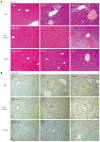Contrast-enhanced micro-computed tomography using ExiTron nano6000 for assessment of liver injury
- PMID: 26185375
- PMCID: PMC4499346
- DOI: 10.3748/wjg.v21.i26.8043
Contrast-enhanced micro-computed tomography using ExiTron nano6000 for assessment of liver injury
Abstract
Aim: To explore the potential of contrast-enhanced computed tomography (CECT) using ExiTron nano6000 for assessment of liver lesions in mouse models.
Methods: Three mouse models of liver lesions were used: bile duct ligation (BDL), lipopolysaccharide (LPS)/D-galactosamine (D-GalN), and alcohol. After injection with the contrast agent ExiTron nano6000, the mice were scanned with micro-CT. Liver lesions were evaluated using CECT images, hematoxylin and eosin staining, and serum aminotransferase levels. Macrophage distribution in the injury models was shown by immunohistochemical staining of CD68. The in vitro studies measured the densities of RAW264.7 under different conditions by CECT.
Results: In the in vitro studies, CECT provided specific and strong contrast enhancement of liver in mice. CECT could present heterogeneous images and densities of injured livers induced by BDL, LPS/D-GalN, and alcohol. The liver histology and immunochemistry of CD68 demonstrated that both dilated biliary tracts and necrosis in the injured livers could lead to the heterogeneous distribution of macrophages. The in vitro study showed that the RAW264.7 cell masses had higher densities after LPS activation.
Conclusion: Micro-CT with the contrast agent ExiTron nano6000 is feasible for detecting various liver lesions by emphasizing the heterogeneous textures and densities of CECT images.
Keywords: ExiTron Nano6000; Liver injury; Micro-computed tomography.
Figures





References
-
- Wurnig MC, Tsushima Y, Weiger M, Jungraithmayr W, Boss A. Assessing lung transplantation ischemia-reperfusion injury by microcomputed tomography and ultrashort echo-time magnetic resonance imaging in a mouse model. Invest Radiol. 2014;49:23–28. - PubMed
Publication types
MeSH terms
Substances
LinkOut - more resources
Full Text Sources
Other Literature Sources
Medical

